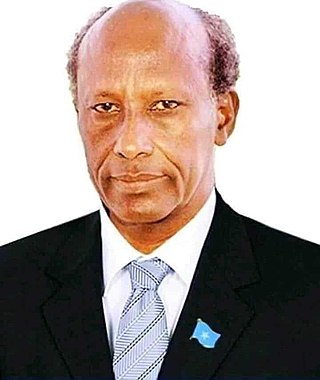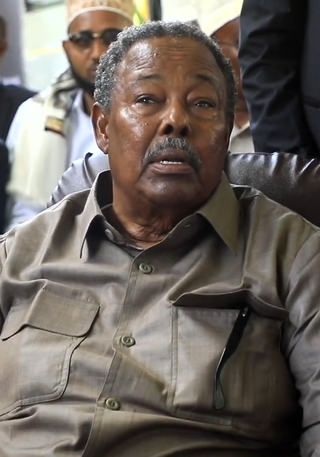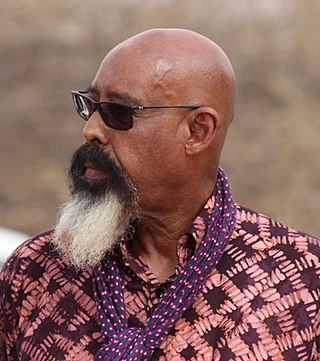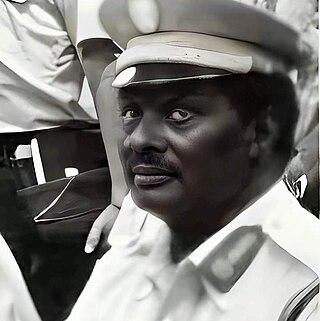Related Research Articles

Mohamed Farrah Hassan Garad, known as General Aidid or Aideed was a Somali general and diplomat.

The United Nations Operation in Somalia II was the second phase of the United Nations intervention in Somalia and took place from March 1993 until March 1995, following the outbreak of the Somali Civil War in 1991. UNOSOM II carried on from the transitory United States-controlled (UN-sanctioned) Unified Task Force (UNITAF), which had been preceded by UNOSOM I. Notably, UNOSOM II embarked on a nation-building mission, diverging from its predecessors. As delineated in UNSCR 814, the operation's objectives were to aid in relief provision and economic rehabilitation, foster political reconciliation, and re-establish political and civil administrations across Somalia.

Ali Mahdi Muhammad was a Somali entrepreneur and politician. He served as President of Somalia from 26 January 1991 to 27 August 1993. The Cairo Agreement in December 1997 designated Ali Mahdi as president once again, a position he held until being succeeded by Abdiqasim Salad in the year 2000.
Hussein Mohamed Farrah Aidid is the son of General Mohamed Farrah Aidid. His father was leader of the Somali National Alliance (SNA), the organization that fought US forces in Mogadishu, through his death on August 2, 1996, after being shot in a tribal battle. Farrah succeeded his father as leader of the SNA, and two days after his father's death, the SNA declared Farrah as the new President, although he too was not internationally recognized as such. Farrah relinquished his claim as president in December 1997, by signing the Cairo Declaration, a significant step toward peace in Somalia.
The United Somali Congress (USC) was one of the major rebel organizations in Somalia. Formed in 1989, it played a leading role in the ouster of the government of Siad Barre in 1991, and became a target of the Unified Task Force campaign in 1993. Following infighting, the USC later splintered into smaller groups. By 2000, with the establishment of a Transitional National Government (TNG), a process of disarmament was put in motion and some moderate ex-USC leaders were incorporated into the new interim administration.

The Somali Civil War is an ongoing civil war that is taking place in Somalia. It grew out of resistance to the military junta which was led by Siad Barre during the 1980s. From 1988 to 1990, the Somali Armed Forces began engaging in combat against various armed rebel groups, including the Somali Salvation Democratic Front in the northeast, the Somali National Movement in the northwest, and the United Somali Congress in the south. The clan-based armed opposition groups overthrew the Barre government in 1991.

United Nations Operation in Somalia I was the first part of a United Nations (UN) sponsored effort to provide, facilitate, and secure humanitarian relief in Somalia, as well as to monitor the first UN-brokered ceasefire of the Somali Civil War conflict in the early 1990s.

Al-Itihaad al-Islami was an Islamist politico-military group in Somalia. Formed in the 1983 through a merger of smaller Islamist groups, the organization was the most powerful Islamic movement in the country during the late 80s and early 90s. It also had the most widespread clan following of all the Islamist factions across the nation and professed the aim of creating a Somali Islamic state.

The Transitional National Government (TNG) was the internationally recognized central government of Somalia from 2000 to 2004.
Following the civil war and the ensuing societal chaos, some factions managed to exert a degree of authority over certain regions of Somalia where they maintained broad, clan-based support. This allowed these factions to establish working administrations and eventually coherent states, and restored order to their regions. This occurred first in Puntland, Southwestern Somalia, Galmudug, Jubaland and finally Banadir.
The Somali National Alliance was a major politico-military faction formed on 16 June 1992 by four different rebel groups that had been in opposition to the regime of former Somali President Mohamed Siad Barre. The SNA was the first major inter-clan and inter-factional political alliance and was considered to be among the most powerful factions of the Somali Civil War. The alliance would most notably face off against the second phase of the United Nations Operation in Somalia in the latter half of 1993.
The Somalia Reconciliation and Restoration Council (SRRC) was a political movement and paramilitary organization based in southern Somalia. It was founded in 2001 by Hussein Mohamed Farrah Aidid, son of the late faction leader Mohamed Farrah Aidid. Growing out of the Somali National Alliance (SNA) led by Aidid, the SRRC was originally formed to oppose the nascent Transitional National Government (TNG) and the Juba Valley Alliance (JVA) in the 2001-2004 period. However, it eventually settled differences with the government and some moderate leaders were incorporated into the new interim administration.

The transitional federal government (TFG) was the government of Somalia between 2004 and 2012. Established 2004 in Djibouti through various international conferences, it was an attempt to restore national institutions to the country after the 1991 collapse of the Siad Barre government and the ensuing Somali Civil War.

Major General Mohammed Said Hersi Morgan, also known as General Morgan or Colonel Morgan, is a Somali military and faction leader. He was the son-in-law of Siad Barre and Minister of Defence of Somalia. He hails from the Majeerteen Darood clan.
The Somali National Front (SNF) was a politico-military organization that operated in southern Somalia during the Somali Civil War and represented one of the major factions involved in the conflict.
Over the course of the Somali Civil War, there have been many revolutionary movements and militia groups run by competing rebel leaders which have held de facto control over vast areas within Somalia.

Aden Abdullahi Nur "Gabyow". was a very senior Somali, Military Officer, Faction Leader, Politician, a leading member and one of the most powerful men in the Somali Democratic Republic.
John Gordon Stewart Drysdale, also known as Abbas Idriss, was a British-born army officer, diplomat, writer, historian, and businessman. He spent much of his life in Somalia, Somaliland and Singapore. Drysdale would serve as an advisor to three successive Somali prime ministers in the 1960s and later for three successive United Nations special envoys during the international intervention in the Somali Civil War. He would also serve as a mediator between warring factions in Mogadishu during 1992 and 1993.
The June 5th 1993 attack on the Pakistani military was a major confrontation that occurred concurrently in different parts of the Somali capital of Mogadishu, between Somali citizens & militias against the Pakistani peacekeeping contingent of UNOSOM II.

The 1992 famine in Somalia resulted from a severe drought and devastation caused by warring factions in southern Somalia, primarily the Somali National Front, in the fertile inter-riverine breadbasket between the Jubba and Shebelle rivers. The resulting famine primarily affected residents living in the riverine area, predominantly in Bay Region, and those internally displaced by the civil war.
References
- ↑ Hirad, Abdalla Ahmed (2009-02-09). "Djibouti's Fourth Somali Peace Conference Is It the End of Political Partisanship?". WardheerNews. Archived from the original on 2009-04-16. Retrieved 2009-08-11.
- ↑ Mukhtar, Mohamed H. "Somali Reconciliation Conferences: The Unbeaten Track". holler Africa!. Retrieved 2009-08-11.
- ↑ "The Dilemma of Disarmament". Time.
- ↑ Somalia - UNOSOM I UN
- ↑ Somalia - UNOSOM II UN
- 1 2 Somalia: From Permanent Conflict to More Peacefulness? Archived 2012-02-05 at the Wayback Machine Searching for Peace in Africa, Jos van Beurden
- ↑ AI Report 1998: Somalia Archived January 9, 2007, at the Wayback Machine Amnesty International
- ↑ Security Council Welcomes Results of Somali Leaders' Meeting in Cairo UN Security Council
- ↑ Somalia/Ethiopia Archived February 22, 2007, at the Wayback Machine CountryWatch
- ↑ Horn of Africa, Monthly Review, January 1998 UNDP
- ↑ Horn of Africa, Monthly Review, February 1998 UNDP
- ↑ Horn of Africa, Monthly Review, March 1998 UNDP
- ↑ Horn of Africa, Monthly Review, April-May 1998 UNDP
- ↑ Horn of Africa, Monthly Review, May-June 1998 UNDP
- ↑ Somalia National Peace Conference Program, hosted at Banadir.com
- ↑ Somalia: Interview with Barre Adan Shire, chairman of the Juba Valley Alliance (JVA) IRIN
- 1 2 UN in Somalia Archived February 25, 2010, at the Wayback Machine United Nations Political Office for Somalia (UNPOS)